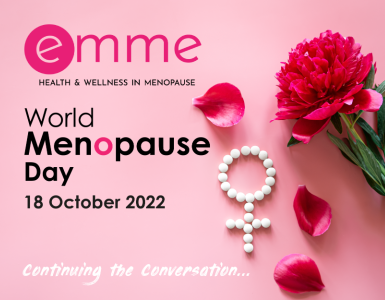by Sue Bedford MSc Nutritional Therapy
So what is Vitamin D and how can it help all of us as we go through perimenopause and menopause? Here we ask leading nutritionist Sue Bedford to explain more.
First things first! What is Vitamin D?
Vitamin D is a fat-soluble steroid hormone precursor (often known as Calciferol) which is only found naturally in small amounts, in a few foods. Vitamin D performs a number of important roles in the body including: contributing to the maintenance of normal absorption and use of calcium and phosphorus levels in the body, for the maintenance of normal bones, teeth and muscle function, and it contributes to the normal functioning of the immune system.
Vitamin D is frequently referred to as the ‘Sunshine Vitamin’ as sunlight is necessary for the synthesis of this Vitamin (which is produced underneath the skin following exposure to sunlight). Vitamin D occurs in two forms: vitamin D2, which is present in a small number of foods, and vitamin D3, which is formed in the skin when exposed to sunlight. Both D2 and D3 are converted into a form that the body can use in the liver and the kidneys. People need varying degrees of vitamin D depending on where they live and their diets.
In the UK (and people living in the northern hemisphere), we don’t get enough of the kind of sunlight that causes our bodies to manufacture vitamin D under the skin. Only one kind of solar radiation does this: UVB sunlight. Vitamin D is synthesised only when we’re exposed to UVB rays – and unless UVB rays are present it doesn’t matter how warm it is, or in fact how brightly the sun is shining: your skin cannot produce vitamin D. Therefore, individuals who live in darker or colder environments are more susceptible to lower vitamin D levels, as are those with darker skin, those who rarely go outside and those who wear clothing that covers most of their skin. In the UK we are exposed to useful levels of UVB from April to October.
It is the opinion of Harvard Medical School that ‘Except during the summer months, the skin makes little if any vitamin D from the sun at latitudes above 37 degrees north or below 37 degrees south of the equator. People who live in these areas are at relatively greater risk for vitamin D deficiency’.
To ensure that we are obtaining enough vitamin D many people take a supplement during the winter months. The Department of Health suggest that from October to March it is advisable to take a daily supplement vitamin D (10 micrograms). Everyone is different so it is advisable to contact your GP or health provider if you have an existing health condition or are unsure.
Vitamin D and the Menopause
Vitamin D is crucial for calcium absorption which is crucial for bone health and strength. When we think about bone health, we often think immediately of calcium and magnesium. But vitamin D is just as necessary for bone health.
Osteoporosis is a real problem facing women in their peri menopause and menopause years. If the women in your family have suffered from have osteoporosis, the chances are quite high that you may well too. Getting enough calcium, magnesium, and vitamin D is therefore an important factor to take into your dietary and lifestyle plan.
And by not getting enough vitamin D, you may also experience more:
- Digestive problems
- Weight gain
- Mental health problems like depression
Adequate Vitamin D levels in the body has been shown to have a positive effect on mood. Since mood symptoms are common in the menopause years, anything that minimizes your mood troubles is worth giving some time and attention to. If you suffer from seasonal affective disorder (SAD) and notice your mood being low during the winter season, you may want to boost your vitamin D intake during those darker months (as mentioned previously).
How can I get more vitamin D naturally?
To make vitamin D more available to us, it is added to dairy products, juices, and cereals that are then said to be ‘fortified with vitamin D’. But most vitamin D – 80% to 90% of what the body gets – is obtained through exposure to sunlight so try and get outside whenever you can!
Here are some food sources of vitamin D:
- Egg yolk
- Meat
- Oily fish such as Sardines, Mackerel, Salmon and Herring
- Fish
- Mushrooms
- Cheese
- Cod liver oil
How do I find out my Vitamin D levels to know if I need to supplement and how much to supplement?
The only way to find out your Vitamin D level is to take a test for it. This can be arranged through your GP, Qualified Nutritional Therapist or Dietician. A convenient way is to take a test at home.
Get started by testing your Vitamin D levels here
















